
A hillside village. (MPM Neg. #: 80088B)
With their arrival in Trinidad, Indian migrants had to contend with a myriad of outside and internal pressures that contributed to the formation of a unique, localized culture, itself very different from its Sub-Continental antecedents. “However ‘Indian’ East Indians in the West Indies may be,” David Lowenthal (1972:146) writes, “they are not much like Indians in India… The extent to which those long cut off from intimate contact with the homeland retain Indian ways depends entirely on how cultural persistence is understood.”
Despite it being a multicultural, multiethnic nation, Trinidad in many ways is bisected along distinctly bounded ethnic lines, namely between Afro and Indo-Trinidadians. And while a great extent of cultural syncretism, appropriation, and adaptation has occurred (namely through the loci of food, religion, and language), the two communities are themselves very distinct (Niehoff & Niehoff 1960:11). In the context of the highly racialized environment of colonial Trinidad, Indians feared losing their cultural identity and therefore retreated into their own cultural and religious cocoons (Maharaj 2008:27). However, it must be understood that these cocoons were highly permeable and many dominant systems of Indian culture, such as the caste system, were unable to survive in Creole Trinidad. Indians entered Trinidad as a minority and acquiesced to the cultural demands dictated by the island’s majority population, Afro- Trinidadians and the population in power, the white plantocracy (Niehoff & Niehoff 1960:11). Broader Trinidadian society, in a myriad of ways, was actively hostile towards South Asian values, beliefs, and relationships. Sugar estate owners completely disregarded South Asian kinship patterns (emphasizing the primacy of the nuclear family over consanguinal structures), dietary restrictions, and caste hierarchy (all varieties of people thusly forced to reside within estate barracks). Colonial laws forbade Hindu crematory practices and Hindu and Muslim marriage unions were viewed as illegitimate until the early twentieth century (Klass 1991:21, 27).
Indentured plantation labor was recruited from across India, where migrants arrived in Trinidad as individuals, lacking any and all connection to their natal villages, families, and caste affiliations. “The foremost problem militating against any simple re-establishment of Indian traditions in Trinidad was the remarkable heterogeneity of the migrant population,” writes Steven Vertovec (1992:87), who lists differences in basic orientations of religious traditions, calendars and practices, alongside caste, kinship structure, political organization, agricultural practices, and language that all together totally reconfigured the Indian cultural consciousness. This cultural mixing produced a composite culture in which caste, family, and religious affiliation (the orienting poles in Indian domestic life) were radically altered. The cultural landscape thus of Indian Trinidad was the result of internal negotiations with various hetrodoxic cultural practice, freely blending disparate Indian practices with those of broader Creole society.
Caste
India’s institution of caste, the pervasive system of social structure dictating both collective and individual behaviors, was not fully reconstituted in the New World. Arthur and Juanita Niehoff define the primary characteristics of the caste system as, “marital exclusivity (caste endogamy); ceremonial cleanliness (principally the avoidance of pollution from people of other castes, and certain dietary restrictions); economic position (the lower castes being in general the poorest); and occupation as defined by caste status” (1960:88). And while Arthur Niehoff stated, “caste is functionally a matter of little concern [in Trinidad]” (1967:162), Morton Klass argues Indo-Trinidadians forged a quasi-caste system, based primarily on property ownership, education, and dietary patterns (East Indians in Trinidad 1961), an observation Aisha Khan (1994) expounds upon in her article regarding juthaa, ritual pollution. Lowenthal astutely posits however, “Caste has, in short, dissolved as a functional form but survived as an aspect of prejudice, a matter of style, and ingredient in personality” (1972:150). With the entrance of Indians into non-agricultural labor sectors as well as professional occupational spheres, coupled with Trinidad’s oil boom (1973-74, present), and the formation of Indian constituent political parties, caste as an orienting structure has ceased to exist.

While traditional occupations associated with caste do not exist as they do in India, some professions such as carpenters and potters were loosely determined by caste during the 1960 Niehoff expedition. With the occupational changes in Trinidad since Independence, caste plays a less-significant role in determining occupation. (E56434)
The implications of the sea voyage endured by emigrating Indian laborers seismically altered the understood dimensions of the caste system. Laborers, caste pariahs culled from the hinterlands, arrived in city ports to be herded onto ships. In the cramped quarters of the hold, amongst foreign bodies, disease, filth, and death, the individual, out of necessity, abandoned the strict notions of pollution and caste exclusivity. The term jahaji bhai (ship brother) arose from the intense friendships formed on board the ships as individuals, having severed their relationships with their families and natal villages. The jahaji bhai thus becomes a point of departure in discussing caste, as many of these friendships circumscribed the strict hierarchy of caste.
In the Niehoff’s study of Trinidad they describe non-Hindu Trinidadians having “almost no sympathy … towards the institution of caste” and moreover there being little economic basis for caste differences, as there are in India with landholders at the top and agricultural laborers comprising the lower castes. Since all Indians arrived together as agricultural laborers, and many from lower castes themselves, there was little incentive to recreate the caste system. By the time Indians began to establish economies and societies independent from the plantations, caste was a lingering memory from a distant place, “an ol’ time Indian t’ing” (Vertovec 1992:100).
Family
“Without the complex framework of kin, marriage, and caste solidarity which existed in India,” writes Stephan Vertovec (1992:101), “the domestic unit became the key referent for social identification and status.” In today’s Trinidad, the joint family still stands as central in the daily lives of Indo-Trinidadians. In its classic form, the joint family is comprised of any number of married couples and their children living together in the same household; money and property are held in common, with the senior male acting as pater famillias and executer of all family affairs (Mandelbaum 1948, cited in Niehoff & Niehoff 1960:99). In present-day rural Trinidad, the classic model still persists; sons often live independently on family land, in quasi-nuclear families, while still deferring to the authority of the father and the principals of the joint family (Niehoff & Niehoff 1960:108). However, the independent nuclear family stands as an ideal type for all Trinidadians, the form indicating an “economic success story” (Nevadomsky 1984); the majority of urban Indo-Trinidadians families are nuclear.
In the early days of immigration, there existed a great disparity of numbers between men and women; this condition was to have lasting implications for Indo-Trinidadian family structure. Indian men, unwilling to marry Creole (Afro-Trinidadian) women, competed among themselves for their relatively few country-women. Between 1874 and 1917, males totaled 68% of the Indian migrant population, while females represented 32% (Niehoff & Niehoff 1960:100). Women, due to their small numbers, were afforded greater personal autonomy in Trinidad (a fact that persists to the present day, where Indo-Trinidadian women enjoy far greater social mobility than their Indian counterparts).[5]
The ramifications of this gender disparity were considerable - “The relative absence of families and children meant that unmarried males and females were generally open to create new types of relationships” (Vertovec 1992:103). Women were given greater authority and autonomy in their own personal affairs, with the ability to dictate the terms of their marriages and engagements. Both widows and unmarried daughters established in Trinidadian society a sense of freedom and respect not found in traditional Indian systems (Mehta 2004). This has led some scholars (MacDonald and MacDonald 1973:193-4) to claim that Indian plantation households became matrifocal in structure, a far departure from the patriarchal systems of North India. However, with the leveling of sex ratios by the 1930s, a stable pattern of family life was established among rural Indians, with a balance struck between patriarchal structure and female independence. What is unique among Indo-Trinidadian families is how they have adapted to broader Creole attitude, towards both Westernization more generally and women’s personal sovereignty, but have also maintained certain ideological qualities, namely the complex patterns of kinship, the maintenance of ritual duties among family members, and authority based on sex and age (Klass 1961, Vertovec 1992:105).
Religion
In their ethnographic expedition to Trinidad, the Niehoffs chose to focus primarily on aspects of Hinduism as they related to the daily lives of Indo-Trinidadians. While various Christian and Muslim festivals may have acquired a certain degree of local color - both Afro-Creole religions and Hinduism have influenced daily practices - the religions as institutions and defined sets of beliefs have themselves stayed very much the same. While they observed the rites and rituals of island Christians and Muslims, Hinduism proved a more fertile ground to explore cultural adaptation, change and continuity. Hinduism has undergone profound changes in the West Indies, especially in Trinidad.
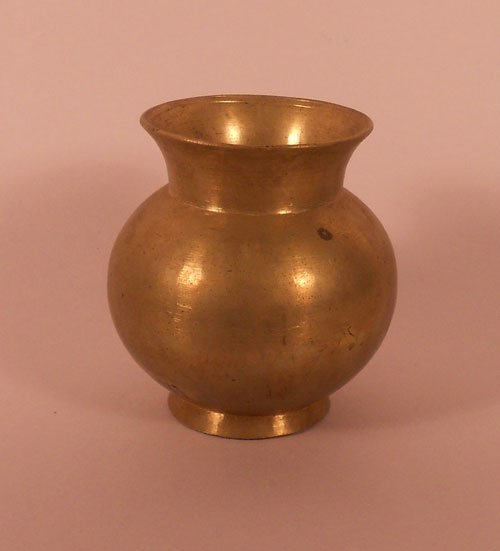
Brass vessels like these are often imported from India at great cost, but are essential in Hindu puja for they are believed to be the only vessel to resist pollution. These vessels are used to offer libations (oil, water, milk) to a deity during the ceremony. (E56418)
“The wide range of geographical and social origins of indentured workers in Trinidad meant that the religious backgrounds of the Indian migrant population were comprised of a massive and jumbled medley of beliefs…” writes Stephan Vertovec in his 1992 study of Trinidadian Hinduism. The religious heterodoxy of Indian Hinduism was homogenized into a composite set of Hindu beliefs practiced by the majority of Indo-Trinidadian Hindus. Localized traditions were quickly abandoned in favor of a standardized orthodoxy that emphasized the worship of major, Sanskritic deities— Vishnu, Lakshmi, Hanuman— with Vishnu and Vaishnavite bhakti (spirited devotion to the deity) becoming the primary orientation for Trinidadian Hindus. While Indian Hinduism is composed of hundreds of various sects and cults, the Niehoffs observed four distinct Hindu sects in Trinidad: Arya Samaj (a 19th century reform movement believing in Vedic infallibility), Sanatan Dharma (the Brahmanic Hindu orthodoxy), Kabir Panth (or “Followers of the Path of Kabir”), and Seunerinis (a monotheistic form of belief popular among lower castes) (Niehoff & Niehoff 1960:112-113). In recent years, scholars have documented the advent of new sects, primarily the meteoric rise of the cult of Sai Baba (Klass 1991) as well as an ecstatic branch of Shaktism (devotion to the Mother Goddess and her various manifestations) that liberally incorporates Afro-Trinidadian Obeah practices (McNeal 2011).

This flag is a marker of shrine dedicated to the god Krishna. Flags such as these dot the island and are constant reminders of Hindus on the island. (E56415 AB)
Upon arrival on the island in 1845, Hindus immediately imbued their new Caribbean landscape with sacred meaning. Individual plots of land and villages were assigned protective godlings (di), while mountains, hills, rivers, and stones were readily viewed as attributes of the supernatural. Hindus quickly established various shrines and mandir (temples) throughout the countryside, thusly adapting and adopting the foreign territory as their own. The Niehoffs describe two such vernacular sacred spaces — the tomb of the white planter Dumphries Baba, where Obeah and Hinduism are fused in the rituals of devotees; and various “growing stones,” rocks which are reputed to be growing at the present time, one such example famously secreting milk (1960:121, 163). Today, the most recognizable emblem of Trinidadian Hinduism is indisputably the Hanuman Murti, located in the town Carapichaima. Standing 85 feet tall, the stone statue is a testament to the presence of Indians in Trinidad and the sizeable strength of Hindus in a broader Trinidadian society (Indo Caribbean World 2003).
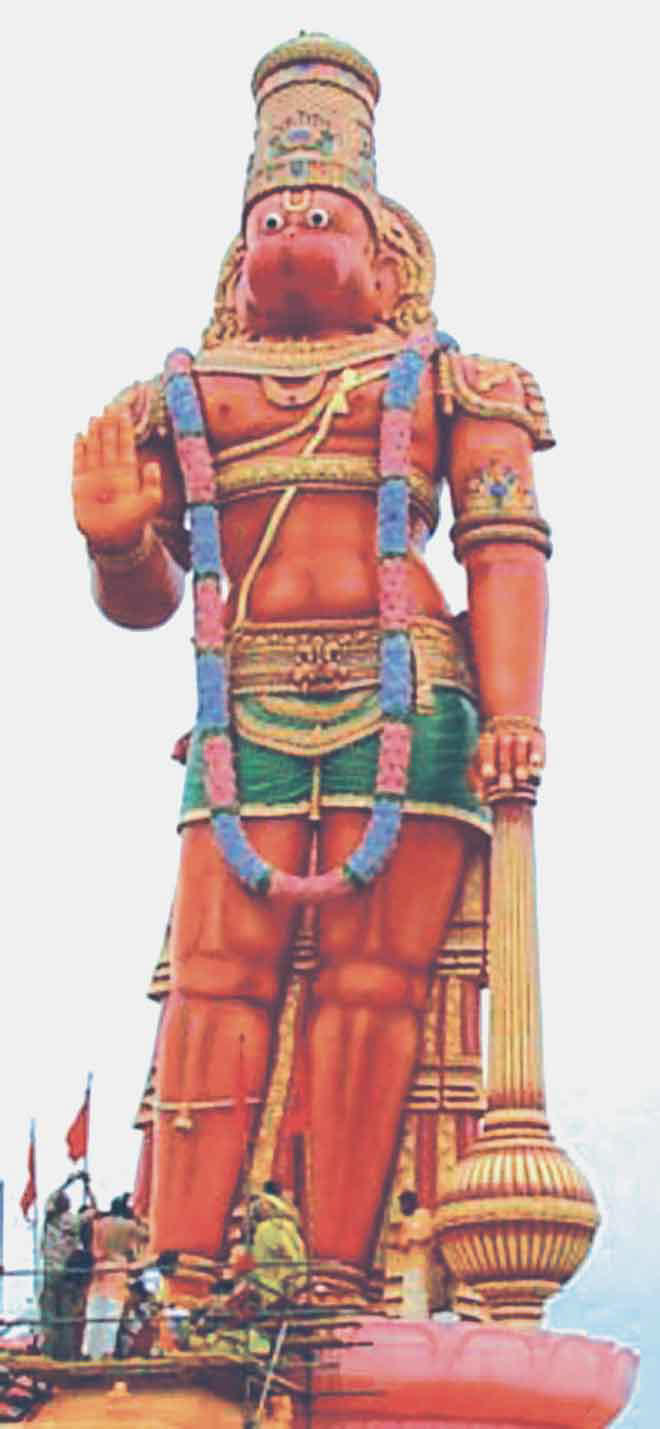
Constructed in 2003, the Hanuman Murti attracts pilgrims from across the island that come to ritually circumambulate the statue (pradakshina) while reciting the sacred Hanuman mantra.
(Courtesy of indocaribbeanworld.com)
The mela (festival) has also come to typify the collective spirit of the Indo-Trinidadian community, with Christians and Muslims often coming to share in the festivities (Younger 2010:109). Alongside festivals such as Diwali, Hoshe’ (a Shi’i festival marking the martyrdom of the Prophet Mohamed’s grandson Hussein ibn Ali), and Phagwa (Holi) are dramatic performances that celebrate the lives and exploits of the gods, the Rama Lila and Krishna Lila being arguably the most famous. With the majority of indentured migrants hailing from the India’s Gangetic Plains (Bihar and Western Uttar Pradesh), these epic, weeks-long dramas represent the continuation of localized Indian traditions in the Caribbean. The Niehoffs note that both the Krishna and Rama Lila were themselves relatively new phenomenon in 1958, with multiple lila being performed simultaneously across the island (1960:125). Both mela and lila have been vital in not only strengthening island Hinduism[6], but also in constructing a sense of Indian collective identity and a sense of continued cultural heritage.

This man is representing Ganesh during the Krishna Lila Pageant. (MPM Neg.#: 80092A)
Work
“Since the importation of coolies, commerce has taken wonderful strides, the export of sugar has increased fivefold and that of cocoa threefold,” wrote James Stark in 1892. Since their initial introduction into Trinidadian society the majority of Indians have labored in the agricultural sector. With Trinidad’s oil boom (both in 1973-74 as well as today) many Indians were able to leave agricultural work and enter into work at oil and natural gas refineries. Since the 1970s, with increased access to education, higher rates of literacy, and greater economic opportunity, many Indians have becomes active players in broader Trinidadian society. Popular imagination, however, still conceives of the Indian as bound to the soil — “In comparison to other ethnic groups… the Indians have retained much of the peasant’s love of the land” (Niehoff & Niehoff 1960:37).
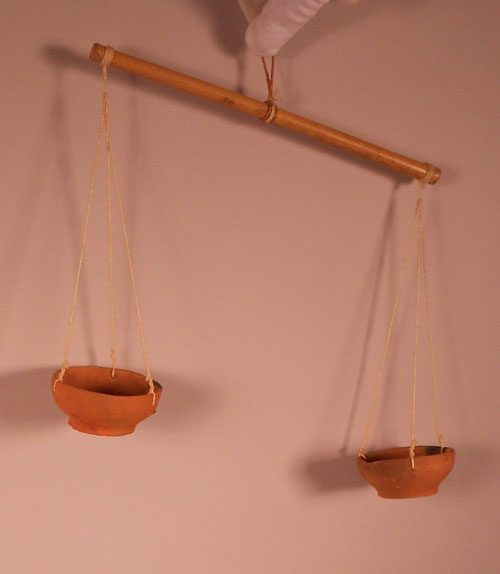
These toy scales are important for they attest to the changing role of Indians within the broader Trinidadian economy - leaving the agricultural sector for private enterprise. The scales demonstrate segments of the population as upwardly mobile and desirous of better economic fortunes and futures. (E56441)
Arthur and Juanita Niehoff, their interests lying primarily in labor practices and patterns, devoted a sizeable amount of their fieldwork to labor and agriculture. The two ascertained the most important crops to Indians were sugar, cocoa, and rice. Sugar and cocoa naturally were tied to the direct livelihoods of Indian farmers, while rice held a symbolic significance in both their daily and ritual lives. In recent decades, both the sugar and cocoa industries have faced severe hardships. In a local economy dominated largely by petroleum exports, Trinidad’s agricultural sector is floundering. Pushed to the brink of collapse in 2007 due primarily to EU economic restructuring and cuts to large subsidies that favored Caribbean sugar, Trinidad’s sugar industry was officially closed by then Prime Minister Patrick Manning (BBC News 2012, Sweet and Sour 2003). This landmark decision primarily affected Indo-Trinidadian communities, who made up the bulk of Caroni Ltd’s (Trinidad’s state owned sugar company) 9,200 employees. The island’s anemic cocoa industry may follow suit if government rejuvenation efforts prove ineffectual (McKenna 2012). For over 150 years, the fortunes of Trinidadian sugar and cocoa directly impacted the lives and livelihoods of the islands Indian populace, and as it stands, little ethnographic research has been conducted regarding the closure of these industries and the effects on the lives of Indo-Trinidadians.

The above cutlass is the primary tool used to harvest sugar cane. (E56421)
Historically, the rice industry has proven to be extremely uneconomic. Cultivated largely by hand on small-scale plots, the government has endeavored to raise production standards through investments in both infrastructure and technology (Hassanali 2012). Notwithstanding the cultivation of rice remains centrally important to rural Indo-Trinidadian communities. Rice serves as a symbol of plenty and an indicator of status for families within communities. Connected also to rice are deeply religious and ritualistic connotations, especially for island Hindus. Each rice field is home to a resident guardian spirit (di) who protects both field and crop from malignant supernatural forces; these spirits are propitiated annually in a ceremony of primary significance to farmers through offerings of rum, cigarettes, and the lighting of candles (Niehoff & Niehoff 1960:35). Rice forms an integral part of Hindu puja (prayer meetings) and weddings, where it is of ritualistic importance. During puja, it is blessed and offered to the deity in worship, while during wedding ceremonies, the bride lets slip rice from a basket seven times (1960:35). The sentimental and utilitarian implications of rice have ensured its central importance in Indo-Trinidadian culture.
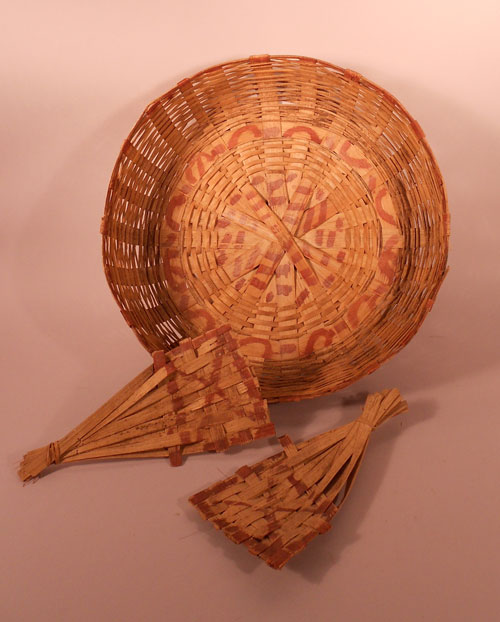
This basket and ladles are used to handle rice during the wedding ceremony. (E56400A-C)
Shared Culture and Broader Social Dynamics
With so many varying religions and ethnicities side by side, Trinidad has witnessed a remarkable degree of cultural syncretism. While certain historical, political, and economic factors have striven to divide Trinidadians along sectarian lines, Trinidadian culture — African, Indian, Chinese, and European — remains remarkably rich due to the diffusive pollination witnessed between communities. The most significant examples of Trinidad’s unique cultural syncretism are in religion, food, and music.
Religious Syncretism
While Christianity, Islam, and Hinduism count the greatest number of adherents in Trinidad, there is a remarkable degree of plurality when it comes to vernacular belief systems. Indo-Trinidadian communities have witnessed an extensive degree of religious incorporation, which the Niehoffs attribute to their position as an insecure minority group for most of Trinidad’s history (1960:10). By adopting the supernatural beliefs from the greater cultural environment, most notably aspects of Christianity and African folk religions, Indians fashioned themselves as Trinidadians (1960:158). Even today, as witnessed by anthropologist Keith McNeal, certain sects of Hinduism (Shakti cults) and charismatic Christian congregations have increasingly adopted aspects of folk religions (Obeah), ecstatic rites, and magic in their religious practices. This example demonstrates how Hinduism, Christianity, and Creole religion of Obeah have mutually influenced each other and altered the way adherents practice and perceive their respective faiths.
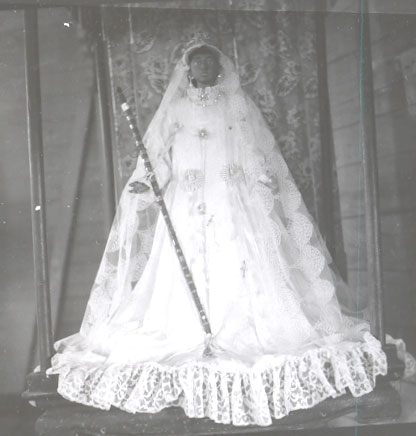
The figure of the Madonna of Siparia. (MPM Neg. #: 80080A)
The most notable example of Trinidad’s religious syncretism lies in the inner sanctum of the church La Divina Pastora in Trinidad’s southern town of Siparia. Here on Maundy Thursday and Good Friday, devout Hindus arrive in droves to propitiate the Black Madonna of Siparia, known colloquially as Siparu Mai (Mother of Siparia). Mothers and barren women arrive by the thousands to either thank Siparu Maifor healthy children or make offerings so as to beget sons. For hours women in turn either pray in Hindi, sing bhajans (devotional songs), or present offerings of rice, oil, flowers, milk, and jewelry to the statue many believe to be a manifestation of the goddess Kali (Niehoff & Niehoff 1960:155). La Divina Pastora and its holy Black Madonna of Siparia appropriately encapsulate the multicultural religious diversity of the island’s population. Various fetes honoring the figure attract Hindus, Muslims, Creoles, Chinese; each community has tangibly altered the way they themselves and other communities view Siparu Mai, thusly creating vernacular forms of worship that better fit the syncretic nature of Trinidadian society.
Christianity and Islam have played a prominent role in the religious and cultural lives of Indo-Trinidadians. In the early days of Trinidad’s colonial history, Indians were a distinctly oppressed minority, both socially and economically. By becoming Christians, Indians were able to improve their prospects by obtaining better jobs, educations, and standards of living. Roman Catholicism, Anglicanism, and Presbyterianism attracted the greatest number of converts. The famous Canadian Presbyterian Mission is responsible for a large number of conversions, but also for the comprehensive education of a majority of the Indian population beginning in 1867 (Niehoff & Niehoff 1960:77). Keith McNeal notes that a proliferation of small, Protestant churches— Baptist, Evangelical, and Pentecostal— is radically changing the religious landscape of the country (2011). For Trinidad’s Indian community, Christianity attracted a sizeable number of converts and quickly influenced the religious practice of Hindus in particular.
The concrete presence of Christianity in myriad of churches dotting the island galvanized Hindus to begin constructing temples with equal zeal across the island, so as to legitimize their religious claims (Niehoff & Niehoff 1960:115). Increasingly, Hindus conduct puja on Sundays in settings much like a church, with idols all grouped together on a front altar, a practice Michele Verna sees as increasingly universal (2012). The historic antagonism of colonial officials towards Hinduism also necessitated changes to ritual components of the religion, most notably Hindus being forbidden to cremate their dead and instead bury them in designated cemetery plots (1960:157). Trinidadian Hinduism has also appropriated Christian festival days such as All Hallows' Eve and Christmas, and accepted Jesus and the Virgin Mary as deities in home altars (1960:157).
Islam, being an Abrahamic religion, was met with less animosity in colonial times than Hinduism, and many of the religious practices of Muslims (prayer five times daily, ritual cleanliness, and the month long fast of Ramadan) were tolerated by colonial officials. Trinidadian Muslims, the Niehoffs noted, were much more secular and did not follow the same prohibitions as their Indian and Middle Eastern counterparts (many Muslims owned and operated rum shops during the time of the Niehoff’s study). The celebration of Hoshe', in which large papier-mâché structures representing the tomb of 6th century martyr Hussein are paraded down the street, has all but lost much of its religious significance, and has become a gigantic party attracting Indians (Muslim, Christian, Hindu) and Creoles, revealing polyphonic plurality and change as localized rites become emblems of national culture (Niehoff & Niehoff 1960:141-145, Korom 2002).
Social Division
Despite its reputation of multicultural plurality, racial divides bitterly plague Trinidadian society. Indian and Creole communities harbor deeply-rooted bitterness towards the other, and while at times communities are able to transcend these constructed barriers, history, economics, and politics often ensure continued animosity. [7] “Probably the greatest source of friction between these two groups stems from economic competition (Niehoff & Niehoff 1960:67)." In terms of early colonial social hierarchy, both Creoles and Indians were at the very bottom, as either slaves or indentured laborers. With the abolition of slavery in 1838, freed Creole slaves left plantations for good, setting up small shops or becoming subsistence farmers. Later, many Afro-Trinidadians would work on Trinidad’s large oil and natural gas fields and were also employed as porters, mechanics, or domestic servants. Eventually many Afro-Trinidadians were given access to higher education and became urban professionals and entrepreneurs, where they were able to create a sizeable and influential middle and upper class (Niehoff & Niehoff 1960:185). As Indians began leaving the agricultural sector and entering into the same professional positions and skilled labor sectors, this created greater competition for limited access to resources, jobs, and markets. During the time of the Niehoff’s study, Indians had become proprietors of large general stores, owners of big businesses, and dominated the island’s transportation industry (1960:25-6, 184). Today Indo-Trinidadians have entered into all island professional and academic sectors, as well as actors on the political stage (the most notable being prime ministers Basdeo Panday and Kamala Prasad- Bissessar). Unfortunately, contemporary politics are dominated by racial division, corruption, and partisanism, a grim reality with serious repercussions for national harmony and collective Trinidadian identity.
Despite both historic and contemporary animosity between Indian and Creole communities, it must be stressed that the culture trajectory of Trinidad has been deeply influenced by both Indian and African communities, as evidenced above (Younger 2008: 98). Trinidad is indebted to Indian populations for their rich culinary contribution, as well their labor upon which the foundations of the nation were built (Lamming 1994); but, as V.S. Naipaul reminds his readers in A House for Mr. Biswas, Indians belong to the larger Trinidadian Creole culture, and efforts to work backwards or rediscover uncontaminated Indian heritage prove extremely difficult, if not impossible (1961). It must be remembered Indians borrowed extensively from Creole communities. Indians learned from Creole populations the Trinidad dialect of English, they also adopted Western dress due in part to their Creole neighbors, and appropriated extensively from Creole religious practices and rituals—most notably Creole systems of magic and spirit beliefs (Niehoff & Niehoff 1960:185).
Food and Music: Indian Roots and Creole Compositions
Food
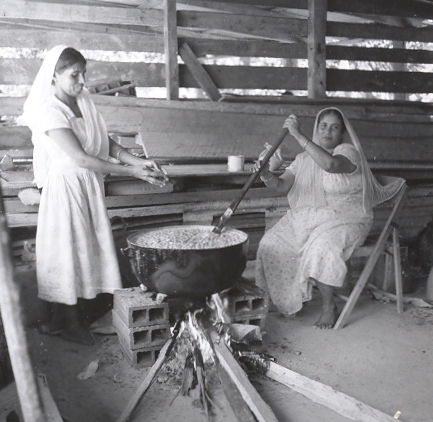
Cooking for a wedding feast. (MPM neg.#: 80162A)
The cuisine of Trinidad represents the plural composition of its society. African influences blend with Indian, Chinese, and European to create a cuisine, like many other in the Caribbean, distinct and complex. Trinidadian food is deeply indebted to Indian laborers who brought with them curries, rotis (flat breads), pilafs (slow cooked rice dishes), and numerous other dishes. Indian food was so completely absorbed into broader Creole food culture that when Arthur Niehoff questioned Afro-Trinidadian communities about the origin of many of their dishes, they had little idea they originated in Indian kitchens (Niehoff & Niehoff 1960). Unlike contemporary Indian immigrant communities in North America and Europe who retain a strong connection with their motherland, Indo-Trinidadian migrants had to adapt to new culinary worlds, recreating remembered cuisines with new ingredients and disparate influences (Pillai 2001). Thus was born a fusion-cuisine that adopted local traditions alongside its own. Roti and rice stand as daily staples across the island, with mango, cilantro, and lime chutneys present on every table. All various manners of curries — vegetarian, goat, pork, beef, and chicken — are daily eaten by all Trinidadians. New cooking techniques such as the use of sugar to brown meats, as well as new ingredients such as callaloo (a type of spinach), salt fish, conch, shark, ackee, and various fruits have altered the Indian diet.
Music
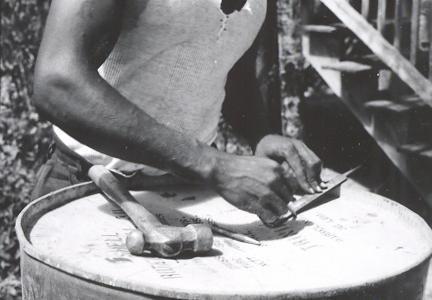
This man is outlining the location of a note on a new steelpan (drum). The craftsman will later use a hammer to “tune” the note to the required pitch. (MPM neg. #: 80111B)
Calypso and Soca: The Creole Foundation
Calypso, originating from African communities in Trinidad, combines African rhythms, lyrical techniques, and general attitude with European instrumentation, scales, and languages. Calypso is in many ways the embodiment of Trinidadian creolization, a hybrid of African heritage and European structures. Calypso utilizes the vibrant sounds of the steelpan, an instrument of Trinidadian origin, and relays the emotions, dramas, and joys from the singer’s life. Calypso originated on Trinidadian sugar plantations, as African slaves, in order to communicate with each other, would sing across the fields, channeling the West African musical tradition of kaiso (Gittens 2010). Soon these field songs would come to represent the musical identity of Afro-Trinidadian communities. In the early twentieth century, Calypso was established as a distinct musical genre; the famous Trinidadian Carnival quickly incorporated Calypso into its celebrations and today it is performed across the island to near universal acclaim.
Duke of Iron: Calypso Invasion, 1946.
The attached link is Lord Kitchener’s famous “Sugar Bum Bum” and represents the earliest development of Caribbean Soca.
Soca is Calypso, but with a more contemporary incarnation. Initially influenced by international pop, Soca increasingly finds influence in Reggae, Dancehall, hip-hop, and electronic mediums. Soca is characterized by faster tempos, funky bass lines, and assorted frenzied percussion.
“Mr. Fete” (2012) by Machel Montano is popular contemporary incarnation of the Soca genre.
Chutney: A Distinctly Indo-Trinidadian Invention
Chutney music, a vernacular musical tradition of Indo-Trinidadian communities, originated in community temples, during wedding celebrations, and in the sugar-cane fields as religious songs, but infused with a dance vibe. The term “chutney” most probably comes from the matikor ritual of the wedding ceremony, where women dance to drums and sing “hot and spicy songs” (Smithsonian Folkways 2012).
An example of Chutney dancing during the matikor celebration, throughout the course of the night songs will be sung regarding both the bride and the groom.
Traditional chatni (latter to be known as Chutney) was played on a dholak (hand-drum), jothat (brass vessel), and with two coins, with the accompaniment of a singer. During weddings or any sort of Indian celebration classical music was played (dhrupad, thumri, or ghazal) followed by chanti, which would mark the commencement of evening festivities (Chutney Pulse 2009). Chutney draws primarily upon ideas from Indo-Trinidadian folk traditions, classical musical conventions, devotional songs, and Bollywood filmi music, but increasingly contemporary Chutney is influenced by Calypso, Soca, and Rap (Chutney Pulse 2009).
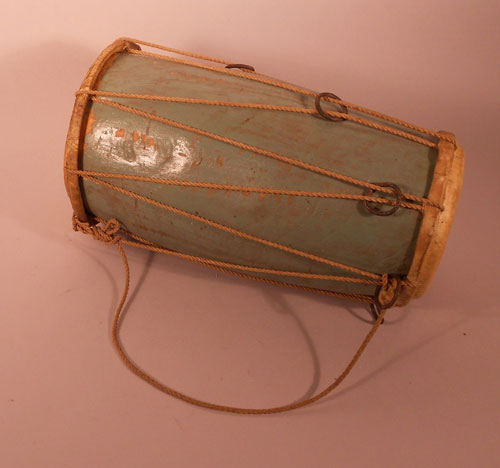
A dholak hand drum. (E56388)
Chutney music in many ways marks the coming of Indo-Trinidadian society into its own. It is a thoroughly modern representation of Indian communities and charts the creolization and westernization of traditional Indians into Trinidadians. It, however, seeks to preserve tradition with many artists singing in a mixture of Hindi/ Bhojpuri alongside English and relying still on instruments such as the dholak (hand-drum), kanjira (tambourine), and harmonium. ChutneyRoots writes, in her blog about all things Chutney:
In terms of music and dance, chutney is not, on the whole, original, but constitutes a revival and repacking of … [Indian] folk genres….Thus, what is dramatically new about modern chutney is not its form but its flouting of the social inhibitions previously restricting dance, and its recontextualisation as a form of public culture enjoyed and performed by men and women together (2009).
Drupatee Ramgoonai, arguably the Queen of Chutney, was once labeled “dutty” (vulgar) for her songs deal often with sex and the consumption of alcohol. Her music incorporates Calyposonian rhythm with Chutney style.
D’Bhuyaa Saaj is a group of Chutney musicians from Trinidad. The above video shows Rasika Dandial (D Rani) and her band singing in English and playing a wide assortment of Indian and Creole instruments — harmonium, tabla, dholak, and steel pan — in rural Trinidad, where Chutney music has its roots.

Performers play cymbals and drums to entertain guests at the end of a wedding ceremony. (MPM Neg. #: 80167B)
[5] Two monographs dealing with contemporary and historical experiences of Indo-Caribbean women more broadly are Brinda Metha’s Diasporic (Dis)locations: Indo-Caribbean Writers Negotiate the Kala Pani (Kingston: University of the West Indies Press, 2004) as well as Rosanne Kanhai’s (ed.) Bindi: The Multifaceted Lives of Indo-Caribbean Women (Kingston: University of the West Indies Press, 2011).
[6] “Villagers have become less self-conscious about their ritual affairs and they have developed an increasing pride in their Hinduism which, until quite recently, was a religion of very little prestige in the colony (Niehoff and Niehoff 1960:126)."
[7] For further in-depth studies of contemporary attitudes towards race, identity, politics, and history please consult the following books:
Aisha Khan Callaloo Nation: Metaphors of Race and Religious Identity among South Asians in Trinidad. Durham: Duke University Press, 2004.
Viranjini Munasinghe Calalloo or Tossed Salad?: East Indians and the Cultural Politics of Identity in Trinidad. Ithaca: Cornell University Press, 2001.

